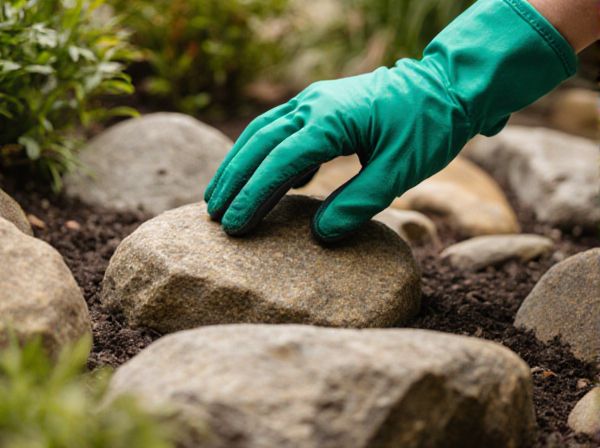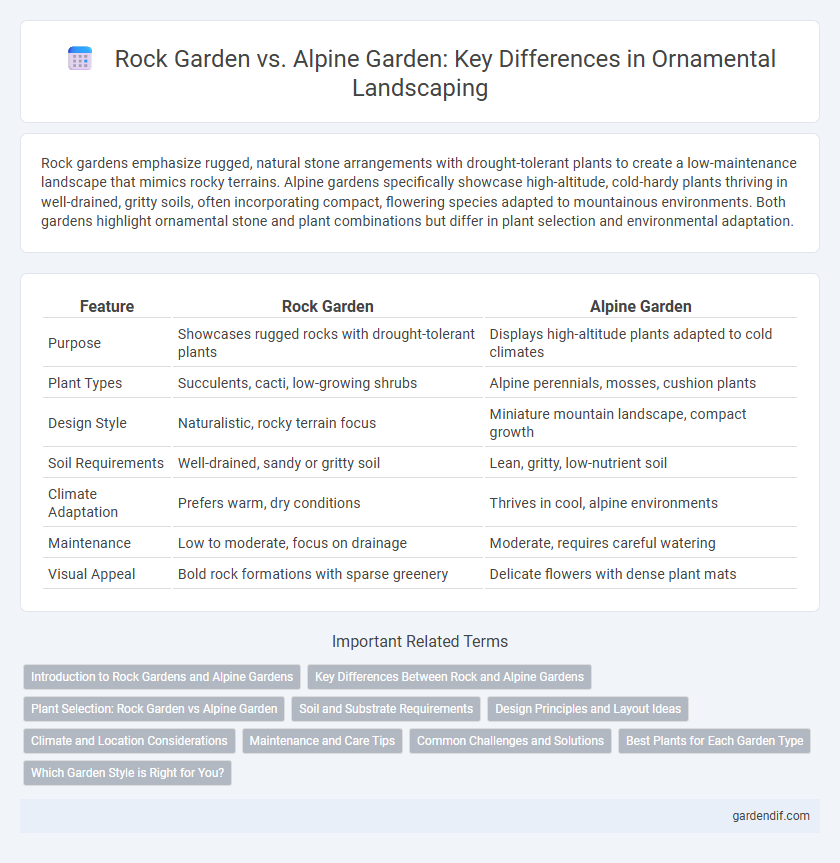
Rock Garden vs Alpine Garden Illustration
Rock gardens emphasize rugged, natural stone arrangements with drought-tolerant plants to create a low-maintenance landscape that mimics rocky terrains. Alpine gardens specifically showcase high-altitude, cold-hardy plants thriving in well-drained, gritty soils, often incorporating compact, flowering species adapted to mountainous environments. Both gardens highlight ornamental stone and plant combinations but differ in plant selection and environmental adaptation.
Table of Comparison
| Feature | Rock Garden | Alpine Garden |
|---|---|---|
| Purpose | Showcases rugged rocks with drought-tolerant plants | Displays high-altitude plants adapted to cold climates |
| Plant Types | Succulents, cacti, low-growing shrubs | Alpine perennials, mosses, cushion plants |
| Design Style | Naturalistic, rocky terrain focus | Miniature mountain landscape, compact growth |
| Soil Requirements | Well-drained, sandy or gritty soil | Lean, gritty, low-nutrient soil |
| Climate Adaptation | Prefers warm, dry conditions | Thrives in cool, alpine environments |
| Maintenance | Low to moderate, focus on drainage | Moderate, requires careful watering |
| Visual Appeal | Bold rock formations with sparse greenery | Delicate flowers with dense plant mats |
Introduction to Rock Gardens and Alpine Gardens
Rock gardens feature a curated landscape of rugged stones combined with drought-tolerant plants to create a naturalistic, low-maintenance decorative space. Alpine gardens specialize in high-altitude plants that thrive in rocky, well-drained soil and harsh climatic conditions, showcasing species such as saxifrage, edelweiss, and alpine asters. Both garden types emphasize texture, elevation, and resilient flora, making them popular choices for ornamental landscaping in limited-space or arid environments.
Key Differences Between Rock and Alpine Gardens
Rock gardens emphasize rugged aesthetics with large stones and drought-tolerant plants to mimic natural rocky landscapes, while alpine gardens focus on high-altitude flora, featuring compact, slow-growing plants adapted to cold, well-drained environments. Rock gardens often incorporate a variety of textures and elevations with boulders and gravel, whereas alpine gardens prioritize botanical accuracy by showcasing rare alpine species and using scree or gravel for optimal root drainage. Maintenance in rock gardens centers on structural stability and weed control, whereas alpine gardens require careful monitoring of soil pH and moisture to replicate mountain conditions.
Plant Selection: Rock Garden vs Alpine Garden
Rock gardens feature a diverse array of drought-tolerant plants such as sedums, sempervivums, and low-growing grasses that thrive in well-drained, rocky soil. Alpine gardens specifically emphasize high-altitude plant species like edelweiss, saxifrage, and gentians that endure cold temperatures and nutrient-poor conditions. Selecting plants for a rock garden focuses on resilience and texture variety, while alpine garden plant selection prioritizes species adapted to harsh mountainous environments.
Soil and Substrate Requirements
Rock gardens demand well-draining, gritty soil composed of sand, gravel, and organic matter to mimic natural mountainous terrains, ensuring roots do not retain excess moisture. Alpine gardens require alkaline to neutral pH substrates rich in lime and humus, promoting nutrient availability for specialized high-altitude plants like saxifrage and edelweiss. Both garden types emphasize excellent drainage but differ in substrate composition based on plant adaptability and environmental simulation.
Design Principles and Layout Ideas
Rock gardens emphasize naturalistic arrangements using large stones and drought-tolerant plants to mimic rugged landscapes, while alpine gardens prioritize compact, low-growing plants adapted to high altitudes with carefully layered rock placements. Effective rock garden design incorporates varied rock sizes and gravel pathways to create texture and visual interest, whereas alpine garden layouts focus on tight clusters and crevice planting to simulate mountain environments. Both styles require strategic positioning for drainage and sunlight, but rock gardens often allow more expansive, flowing designs compared to the structured, miniature landscapes typical of alpine gardens.
Climate and Location Considerations
Rock gardens thrive in well-drained soils with moderate to low water requirements, making them ideal for temperate climates with occasional rainfall. Alpine gardens are specifically designed for high-altitude environments, requiring cooler temperatures, excellent drainage, and exposure to full sun to replicate mountain conditions. Choosing between these garden types depends on local climate factors such as temperature range, precipitation levels, and soil composition.
Maintenance and Care Tips
Rock gardens require well-drained soil and regular weeding to prevent invasive plants from overpowering the design, while alpine gardens demand specific attention to moisture levels and protection from excessive heat. Both garden types benefit from mulching to retain soil moisture and reduce erosion, yet alpine gardens often need winter protection due to the delicate nature of high-altitude plants. Proper pruning and seasonal fertilization tailored to the chosen plants are crucial for maintaining health and aesthetic appeal in each garden style.
Common Challenges and Solutions
Rock gardens often face drainage issues and soil erosion, which can be mitigated by using well-draining gravel and strategically placed rocks to control water flow. Alpine gardens encounter difficulties with nutrient-poor soils and harsh weather conditions; incorporating compost and selecting hardy, drought-tolerant plant species helps improve soil health and plant resilience. Both garden types benefit from regular maintenance, including weed control and seasonal pruning, to ensure optimal growth and aesthetic appeal.
Best Plants for Each Garden Type
Rock gardens thrive with drought-tolerant plants like sedum, sempervivum, and dwarf conifers that complement rocky, well-drained soils. Alpine gardens favor cold-hardy, slow-growing species such as saxifrage, edelweiss, and gentians, adapted to high-altitude conditions with poor, gritty soil. Selecting plants suited to each garden's microclimate and soil type ensures optimal growth and visual appeal.
Which Garden Style is Right for You?
Rock gardens emphasize rugged, natural stone arrangements combined with drought-tolerant plants, ideal for xeriscaping and low-maintenance landscaping. Alpine gardens feature high-altitude plants such as saxifrage and edelweiss, thriving in well-drained soil with cooler conditions, perfect for gardeners seeking compact, delicate blooms. Choosing between rock and alpine gardens depends on your climate, soil type, and aesthetic preference for either dramatic rock formations or a miniature mountain landscape.
Rock Garden vs Alpine Garden Infographic

 gardendif.com
gardendif.com